55 Years Ago: Final Preparations for the Planned Launch of Apollo 1
With President John F. Kennedy’s end-of-the-decade target of landing a man on the Moon approaching, NASA set ambitious goals for 1967 to human-rate the Saturn IB and Saturn V rockets and to test the Apollo Command and Service Modules (CSM) and the Lunar Module (LM) — seven Saturn launches in all. The first of these missions, officially called Apollo-Saturn-204 (AS-204), but more commonly known as Apollo 1, would be a 14-day Earth orbital test flight of a Block I Apollo CSM. NASA assigned veterans Virgil I. “Gus” Grissom and Edward H. White and spaceflight rookie Roger B. Chaffee to the mission, with spaceflight veteran Walter M. Schirra and rookies Donn F. Eisele and R. Walter Cunningham as their backups. Launch was planned for Feb. 21, 1967. Preparations for the follow-on missions were well underway in January 1967 and, if they all accomplished their objectives, NASA hoped that a Moon landing might be achievable by late 1968. These ambitious plans, already threated by spacecraft and rocket-stage delivery delays, were upended by the tragic events of Jan. 27, 1967.
Apollo-Saturn 204/Apollo 1
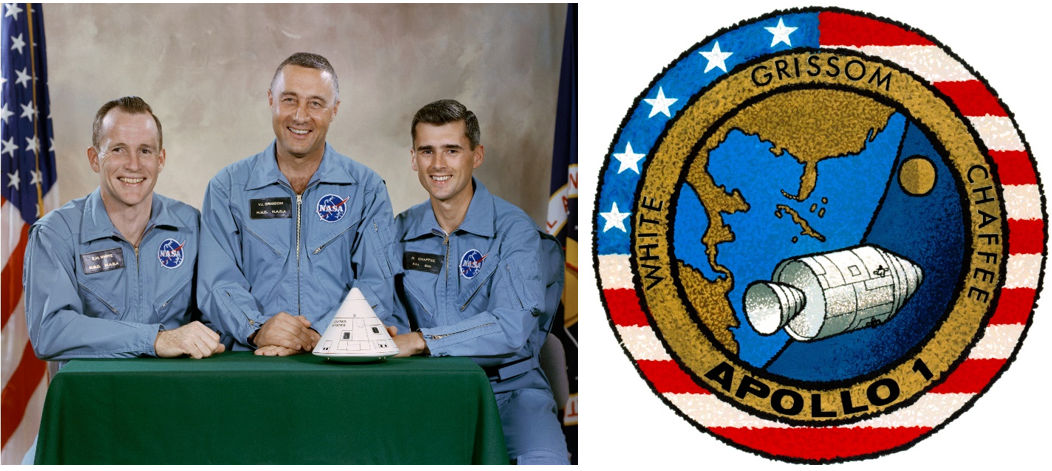
Left: Edward H. White, left, Virgil I. “Gus” Grissom, and Roger B. Chaffee, the crew of Apollo AS-204, also known as Apollo 1. Right: The mission patch of the Apollo 1 crew. Credits: NASA
Early Apollo spacecraft were called Block I and designed to test the CSM. Two Block I spacecraft flew suborbital test missions without a crew in 1966. The later Block II spacecraft differed from the Block I in many aspects, with the most prominent being that they carried a docking system and transfer tunnel, allowing them to dock with the LM.
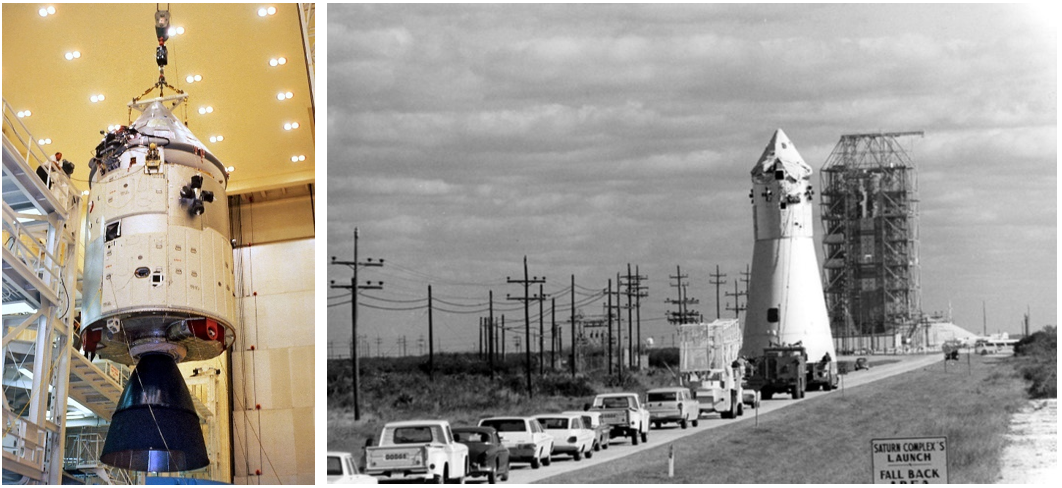
Left: In the Manned Spacecraft Operations Building (MSOB) at NASA’s Kennedy Space Center in Florida, workers prepare to mate the Apollo 1 Command and Service Module with the Spacecraft Lunar Module Adapter. Right: Workers truck the assembled Apollo 1 spacecraft from the MSOB to Launch Complex 34 at Cape Kennedy Air Force Station, now Cape Canaveral Space Force Station. Credits: NASA
The Block I spacecraft assigned to fly Grissom, White, and Chaffee, CSM-012, successfully completed its altitude chamber tests in late December 1966 in the Manned Spacecraft Operations Building (MSOB) at NASA’s Kennedy Space Center in Florida. On Jan. 3, 1967, workers in the MSOB removed CSM-012 from the altitude chamber, installed its large Service Propulsion System (SPS) engine nozzle and, two days later, stacked it atop the Spacecraft LM Adapter, or SLA. On Jan. 6, after installing two sets of Reaction Control System thrusters on the Service Module (SM), workers trucked the assembled spacecraft to nearby Launch Complex 34 at Cape Kennedy Air Force Station, now Cape Canaveral Space Force Station.
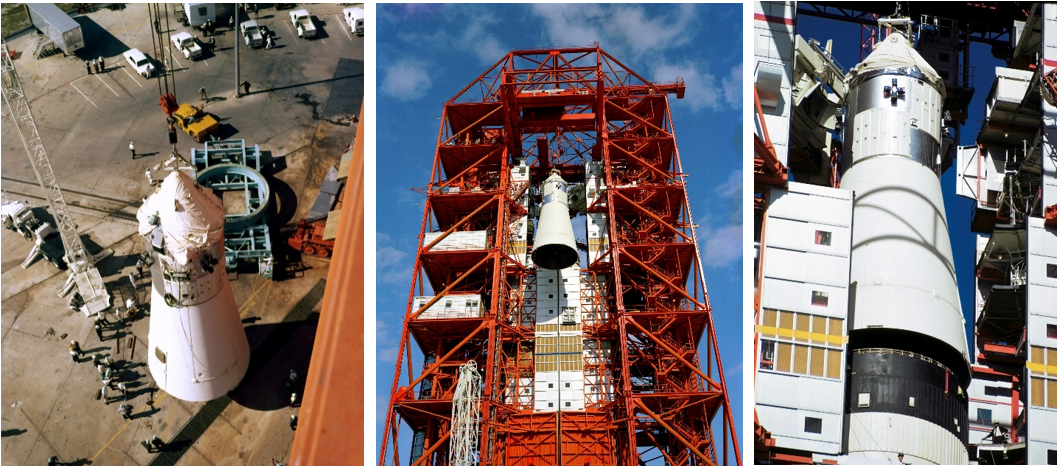
Left: At Launch Complex 34, workers begin lifting the Apollo 1 spacecraft for stacking on its Saturn IB rocket. Middle: The Apollo 1 spacecraft being lifted onto its Saturn IB rocket. Right: Workers finish installing the Apollo 1 spacecraft atop its Saturn IB rocket. Credits: NASA
At Launch Complex 34, ground crews lifted the Apollo 1 spacecraft and placed it atop the Saturn IB rocket’s S-IVB second stage, then added the Launch Escape System tower to the top of the spacecraft and began several weeks of preparation, maintenance, and testing. On Jan. 10, workers replaced one of the eight H-1 engines on the rocket’s S-IB first stage because of an improperly manufactured turbine blade. Six days later, technicians loaded the SM’s power-generating fuel cells and electrically mated the spacecraft to its launch vehicle in preparation for a series of integrated tests.

Left: Apollo 1 crew of Roger B. Chaffee, left, Edward H. White, and Virgil I. “Gus” Grissom suit up in the Flight Crew Training Building. Credits: NASA. Right: Grissom, front, White, and Chaffee, still inside, leave the Flight Crew Training Building on their way to Launch Complex 34 to meet with the media. Credits: Courtesy Armando Oliu
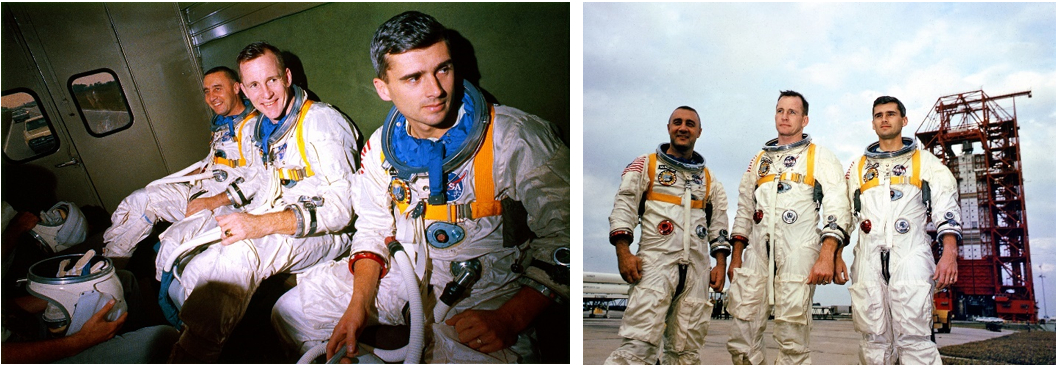
Left: Apollo 1 astronauts Virgil I. “Gus” Grissom, left, Edward H. White, and Roger B. Chaffee in the transfer van on their way to Launch Complex 34 for a media event. Right: Grissom, left, White, and Chaffee pose for the media with Launch Complex 34 in the background. Their rocket and spacecraft are hidden from view by the protective enclosures of the service structure. Credits: NASA
The prime and backup crews spent considerable time rehearsing their flight in the Apollo Mission Simulator at Kennedy and the mission evaluator at the spacecraft’s manufacturer, North American Aviation (NAA) in Downey, California. With numerous changes being made to their spacecraft and to procedures, engineers found it difficult to keep the simulators up to date, creating concern and frustration among the astronauts. On Jan. 17, Grissom, White, and Chaffee took a break from simulator exercises, donned their spacesuits, and took the astronaut transfer van to Launch Complex 34 to meet with reporters. They posed for photographers and film crews with the launch gantry in the background, the rocket concealed by the environmental protection panels of the service structure. They answered reporters’ questions about their training and the upcoming launch just five weeks away. After the event, they returned to the simulator for more training. Their backups — Schirra, Eisele, and Cunningham — spent much of the week of Jan. 16 training in the Downey facility’s mission evaluator. Grissom, White, and Chaffee joined them there at the end of the week for their turn in the evaluator.
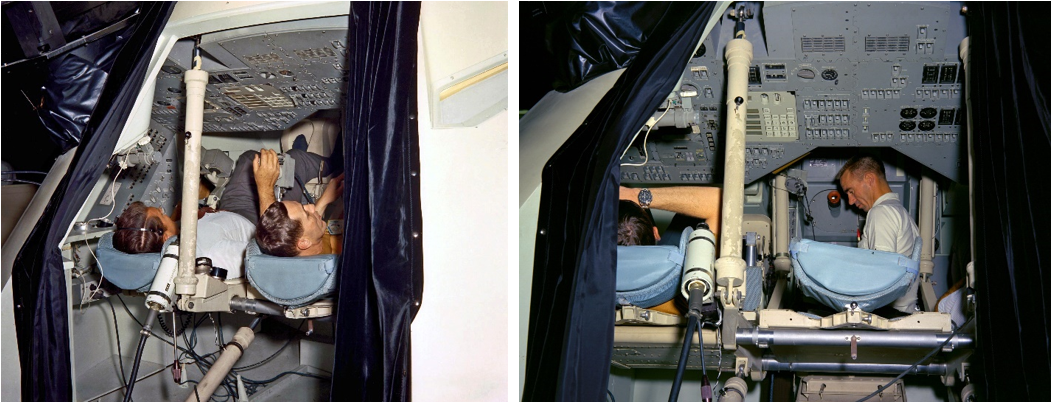
Left: Apollo 1 backup astronauts Walter M. Schirra, left, and Donn F. Eisele in the mission evaluator at North American Aviation’s plant in Downey, California. Right: Schirra and fellow Apollo 1 backup astronaut R. Walter Cunningham in the Downey mission evaluator. Credits: NASA
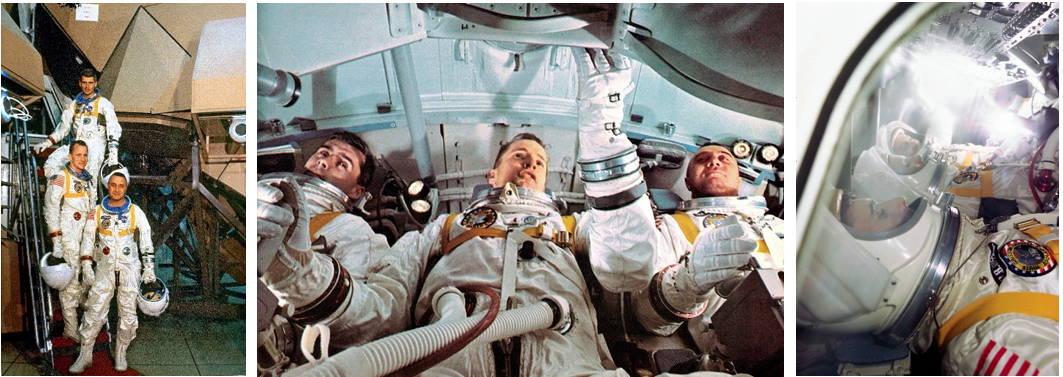
Left: The Apollo 1 crew of Virgil I. “Gus” Grissom, front, Edward H. White, and Roger B. Chaffee pose in front of the Apollo Mission Simulator (AMS) at NASA’s Kennedy Space Center in Florida. Middle: Grissom, left, White, and Grissom inside the AMS. Right: Chaffee, front, White, and Grissom as seen through one of the simulator’s windows. Credits: NASA
The Apollo 1 flight plan called for an open-ended mission of up to 14 days if the Mission Control team judged the spacecraft systems and the crew’s health to be adequate. The primary objectives included testing the spacecraft’s life-support systems, as well as the main SPS engine, which, on lunar missions, would be used for critical maneuvers to insert the spacecraft into lunar orbit, propel it back toward Earth, and conduct midcourse trajectory maneuvers. The mission plan included eight SPS test firings, the final one to deorbit the spacecraft for re-entry during its 208th revolution around Earth. On the mission’s first day, following separation from the rocket’s S-IVB second stage, the astronauts planned to fly in formation with it for 20 minutes and photograph its condition.
During the mission, the astronauts planned to spend about 60 hours performing nine experiments: five medical, three scientific, and one technological. They planned at least one television broadcast — the first to be beamed down from an American crewed spacecraft in orbit. Because Apollo 1 would be the first crewed test of the spacecraft, the astronauts planned to sleep in shifts, with at least one of them awake at all times to monitor its systems. If the mission went the full duration, the spacecraft would bring the astronauts home to a splashdown in the Atlantic Ocean north of Puerto Rico after 330 hours and 50 minutes, breaking the Gemini VII record as the longest human spaceflight by about 15 minutes. Assuming an on-time launch on Feb. 21, splashdown would occur on March 7, with the U.S.S. Essex (CVS-9) serving as the prime recovery ship.

The three veteran flight directors assigned to the Apollo 1 mission, from left: Christopher C. Kraft, Eugene F. Kranz, and John D. Hodge. Credits: NASA
Three teams of flight controllers were training to support the Apollo 1 mission from Mission Operations Control Room 1 in the Mission Control Center at the Manned Spacecraft Center in Houston, now NASA’s Johnson Space Center in Houston. Three veteran flight directors were at the helm — with Christopher C. Kraft, NASA’s original flight director and developer of the mission control concept, leading the Red Team; Eugene F. Kranz leading the White Team; and John D. Hodge leading the Blue Team. Throughout the mission, the teams would monitor the spacecraft’s systems and the crew’s health and provide assessments of whether the mission could continue. For the first six orbits, they would decide after each revolution whether to continue the mission to accomplish the highest-priority objectives, then do daily reassessments the rest of the mission.
The last full week of January 1967 began with a NASA press release on the 23rd confirming the planned Feb. 21 launch date for Apollo 1. The prime and backup crews returned to Kennedy for additional testing and simulator runs. Expressing his continuing frustration with the simulator’s inability to keep current, Grissom adorned it with a lemon from his backyard. On Jan. 25, Schirra, Eisele, and Cunningham began a test inside the spacecraft at Launch Complex 34. Referred to the “plugs-in” test, it simulated a countdown with the spacecraft remaining powered by ground sources, instead of switching to its own internal sources. They encountered numerous minor glitches that extended the test into the early morning hours of the next day. On Jan. 27, Grissom, White, and Chaffee were scheduled to conduct the “plugs-out” test, during which, at the end of the mock countdown, the spacecraft would switch to its own internal power. If this test — in which the astronauts would be wearing their spacesuits with spacecraft’s hatches closed and the cabin pressurized with 100% oxygen at 16 pounds per square inch as if on launch day — went well, it would clear the way for subsequent milestones like the Flight Readiness Test on Jan. 30, management’s Flight Readiness Review on Feb. 10, the final dress rehearsal Countdown Demonstration Test on Feb. 17, and the launch itself on Feb. 21.
Follow-on missions planned for 1967
Apollo-Saturn 206
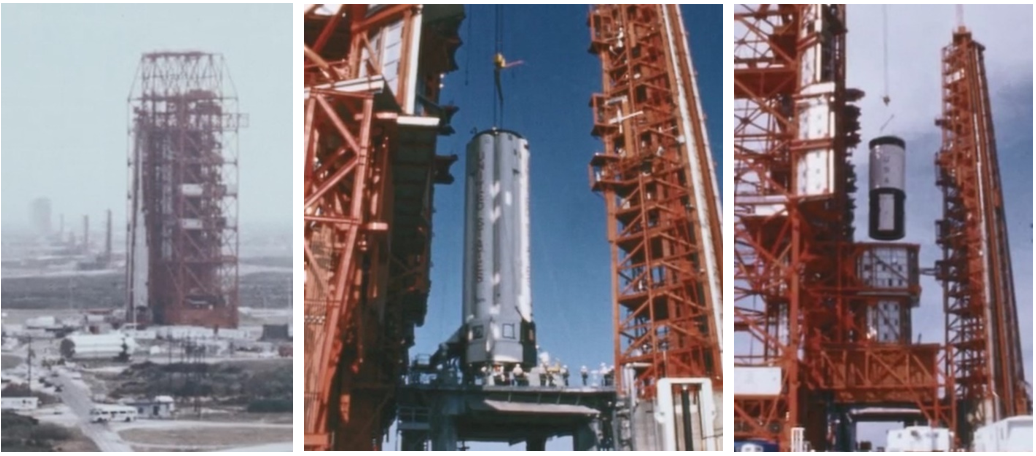
Left: At the Cape Kennedy Air Force Station in Florida, now Cape Canaveral Space Force Station, on its way to Launch Complex 37B (LC-37B), the S-IB first stage of the Saturn IB rocket for the AS-206 mission rolls by Launch Complex 34, where the Apollo 1 rocket and spacecraft are stacked. Middle: Workers place the AS-206 S-IB stage on LC-37B. Right: Workers stack the S-IVB second stage of the AS-206 rocket. Credits: NASA
The mission to follow AS-204, possibly as early as the first quarter of 1967, intended to carry out the first uncrewed test of the LM in Earth orbit. Although LM-1 missed its November 1966 delivery date, NASA pressed ahead with assembly of its Saturn IB rocket, designated AS-206, to be ready whenever LM-1 arrived. Workers rolled the rocket’s S-IB first stage to Launch Complex 37B on Jan. 19, passing by Launch Complex 34, where engineers were testing the AS-204 rocket and Apollo 1 spacecraft. The next day, they lifted the stage onto the pad and, three days later, topped it off with its S-IVB second stage. This marked the second and final time that two Saturn IB rockets occupied two pads at the same time; the first time occurred between April 21 and July 5, 1966.
Apollo-Saturn 205/208

Left: James A. McDivitt, left, David R. Scott, and Russell L. Schweickart, the AS-205/208 crew, in Apollo Command Module-101 (CM-101) at North American Aviation’s Downey, California, plant. Middle: McDivitt, left, Scott, and Schweickart during a Crew Compartment Fit and Function test in CM-101. Right: The backup AS-205/208 crew of Thomas P. Stafford, left, John W. Young, kneeling, and Eugene A. Cernan waiting to climb aboard CM-101. Credits: NASA
Assuming the uncrewed LM-1 flight successfully completed its objectives, NASA’s plans called for the first crewed LM test as early as August 1967. This complex mission involved two Saturn IB launches. The first, AS-205, would launch the crew of James A. McDivitt, David R. Scott, and Russell L. Schweickart aboard CM-101, the first of the Block II Apollo spacecraft, equipped with a docking system and a transfer tunnel. Thomas P. Stafford, John W. Young, and Eugene A. Cernan comprised the backup crew. A day or so later, a second Saturn IB, AS-208, would launch LM-2 without a crew. McDivitt’s crew would then dock their spacecraft with the LM and activate its systems for a thorough checkout before returning to Earth in Command Module-101 (CM-101), with the uncrewed LM burning up on re-entry, as it didn’t carry a heat shield. The McDivitt and Stafford crews conducted a Crew Compartment Fit and Function check of CM-101 at NAA’s Downey facility from Jan. 26-27, 1967. While at Downey, Stafford’s crew also conducted tests in CM-014, a virtually identical vehicle to Apollo 1’s CM-012, to provide engineering support for the launch preparations in Florida.
Saturn-Apollo 501
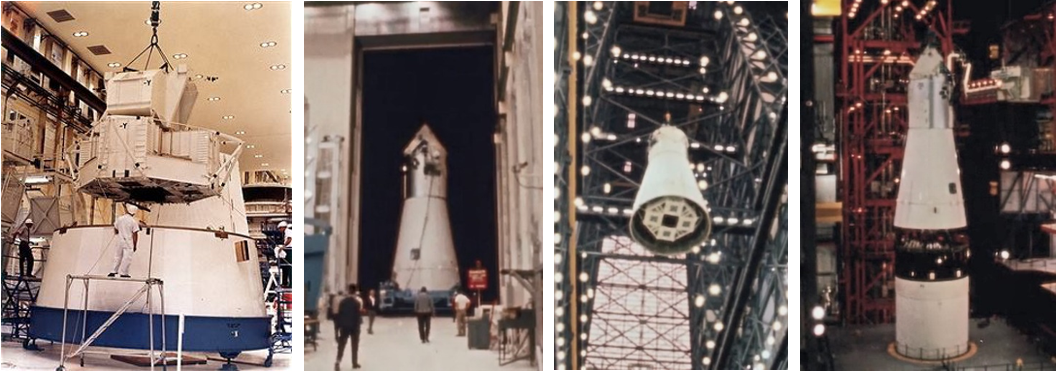
Left: Workers in the Manned Spacecraft Operations Building (MSOB) at NASA’s Kennedy Space Center in Florida lower the Lunar Module (LM) Test Article-10R (LTA-10R) into the Spacecraft LM Adapter (SLA). Middle left: The assembled spacecraft 017 departs the MSOB for the rollover to the Vehicle Assembly Building (VAB). Middle right: In the VAB, workers lift the assembled spacecraft 017 for mating with its Saturn V rocket, with the LTA-10R visible at the bottom of the SLA. Right: Workers lower spacecraft 017 onto the Saturn V SA-501 rocket. Credits: NASA
Preparations were also underway at Kennedy for the launch of the first Saturn V Moon rocket, known as SA-501, then targeted for liftoff in the second quarter of 1967. The goal of this uncrewed mission was to test all three stages of the Saturn V, the SPS engine, and the CM’s heat shield as it re-entered the atmosphere at lunar return velocity. Workers in Kennedy’s cavernous Vehicle Assembly Building (VAB) stacked the S-IC first stage of the Saturn V on a Mobile Launcher in September 1966. Because the S-II second stage had not yet arrived, they instead used a spool-shaped spacer so they could then stack the rocket’s S-IVB third stage in November. In the MSOB, workers prepared the spacecraft for the SA-501 flight. In December 1966, they placed the LM Test Article-10R (LTA-10R), designed to simulate the mass properties of a LM, inside the SLA. The Block I spacecraft for the SA-501 flight arrived at Kennedy in late December, and comprised CM-017 and SM-020, the latter used because SM-017 was destroyed during a pressure test failure on Oct. 25, 1966. On Jan. 4, 1967, workers installed the SPS engine nozzle, just one day after performing the same activity for Apollo 1’s CSM-012, and then mated the spacecraft with the SLA. Eight days later, ground crews transferred the assembled spacecraft to the VAB and stacked it atop the rocket for integrated tests from Jan. 23-24. The rocket’s second stage finally arrived on Jan. 21, requiring destacking of the rocket in February so the real stage could replace the spacer.
Saturn-Apollo 502 and 503
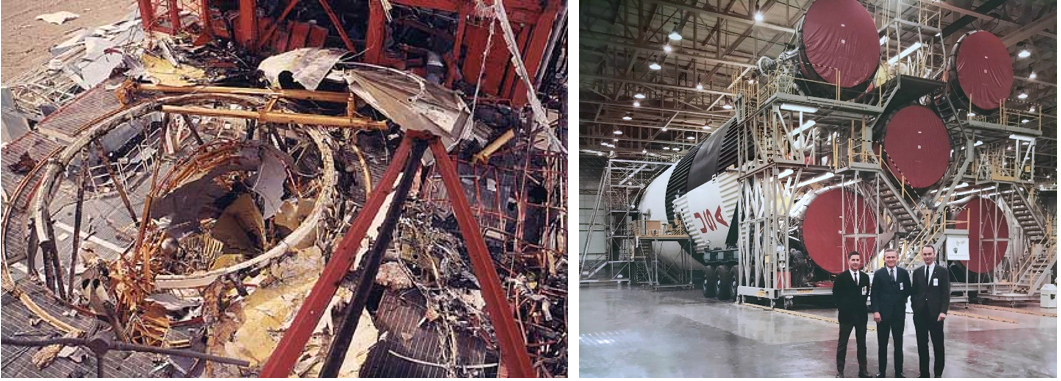
Left: Remains for the Saturn V third stage and the test stand following the Jan. 20, 1967 explosion. Credits: NASA. Right: William A. Anders, left, Frank Borman, and Michael Collins assigned to the SA-503 mission, the first crewed flight of the Saturn V, pose in front of the first stage of the Moon rocket in 1967. Credits: Courtesy of The Boeing Co.
NASA planned to conduct the second uncrewed test flight of the Saturn V on the SA-502 mission in the second half of 1967. In many ways similar to the SA-501 mission, SA-502 used CM-020 and SM-014 in the last planned flight of a Block I Apollo spacecraft. The first Saturn V to carry a crew, SA-503, was tentatively planned for late 1967, assuming all previous flights completed their objectives. NASA assigned Frank Borman, Michael Collins, and William A. Anders as the crew for this mission, with Charles “Pete” Conrad, Richard F. Gordon, and Clifton C. Williams as their backups. The Saturn V would carry both a CM and a LM, and the crew would simulate many of the maneuvers of a lunar mission, including raising their orbit to a then record 4,000 miles. The Saturn V stages were still undergoing testing, and the third stage suffered a catastrophic failure on Jan. 20, 1967, just prior to a test firing.
With special thanks to John B. Charles, Gerald D. Griffin, Gary W. Johnson, Richard W. Nygren, John Tribe, and Armando Oliu for providing expert help with this article.
To be continued …
World events in January 1967:
- Jan. 2 – Ronald W. Reagan is sworn in as California’s 33rd governor.
- Jan. 6 – “The Milton Berle Show” last airs on ABC.
- Jan. 6 – KHTV Channel 39 in Houston goes on the air.
- Jan. 10 – Edward W. Brooke from Massachusetts is seated as the first popularly elected African American U.S. senator.
- Jan. 10 – Segregationist Lester Maddox inaugurated as governor of Georgia.
- Jan. 10 – The Public Broadcasting Service, or PBS, the National Educational Television, begins as a 70-station network.
- Jan. 11 – San Diego is granted a National Basketball Association franchise called the Rockets; the team moves to Houston in 1971.
- Jan. 14 – Sonny & Cher release the single “The Beat Goes On.”
- Jan. 15 – In the first Super Bowl, the Green Bay Packers beat the Kansas City Chiefs 35-10 at the Los Angeles Coliseum.
- Jan. 27 – The United States, the Soviet Union, and the United Kingdom sign the United Nations Outer Space Treaty.
- Jan. 28 – The Rolling Stones release “Let’s Spend the Night Together.”







